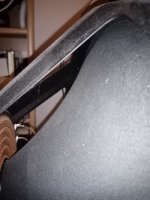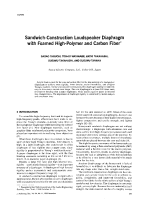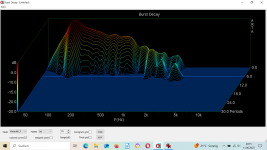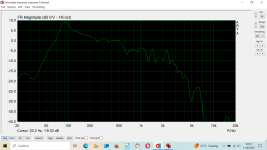.44 qts + 270 L vas + 35hz fs, i see you would have a huge natural 4th ported.
Seems sensitivity is too high, but 4ohm and 5mm xmax, higher fs, maybe it is right.
I had amazing results with 4.3mm xmax 18's (ran 4), so i always recommend more drivers over 1 driver with 48mm xmax. Most drivers don't get much louder beyond 100w anyway.
I like it, basically boost the schmoo out of it down to tuning, but be sure to roll it of (subsonic protection) below tuning.
For you, tuning to 25hz, may only need 100w per driver to get to xmax at maybe 37hz........
I miss my 18's........
Seems sensitivity is too high, but 4ohm and 5mm xmax, higher fs, maybe it is right.
I had amazing results with 4.3mm xmax 18's (ran 4), so i always recommend more drivers over 1 driver with 48mm xmax. Most drivers don't get much louder beyond 100w anyway.
I like it, basically boost the schmoo out of it down to tuning, but be sure to roll it of (subsonic protection) below tuning.
For you, tuning to 25hz, may only need 100w per driver to get to xmax at maybe 37hz........
I miss my 18's........
Ya, there is always the question if the parameters are true.
Mostly the plus minus travel of the cone can not be easily found out.
One method is tearing one driver apart and measuring the thickness of the pole plate and the winding depth of the voice coil. The other is making distortion measurements with different levels of loudness which is not invasive.
The only hint that the parameters as such function is the calculation of parameters in WinISD. If these do not work - WinISD calculates different parameters -if you put that function on - than you have to measure Thiele Small parameters by yourself.
Mr Herget from Germany is discussing cone travel on his website.
Sorry its in german but maybe some translator can help you out:
HTH Hub-Info
Image is from his website.
Not always is a long cone travel ideal. If you do not have potent ampifiers and your bass driver has small magnets than a shorter cone travel maximizes efficiency for a given power input.
This is certainly the fact with a battery powered bluetooth loudspeaker like this one:
Tuning / Tweaking of BP 115 A
If you search for maximum bass level you can either choose more cone travel or more driver surface - this is why i use four 18 inch drivers per side. The drivers were very affordable - so there is no necessity to use only one 18 inch driver per side.
Mostly the plus minus travel of the cone can not be easily found out.
One method is tearing one driver apart and measuring the thickness of the pole plate and the winding depth of the voice coil. The other is making distortion measurements with different levels of loudness which is not invasive.
The only hint that the parameters as such function is the calculation of parameters in WinISD. If these do not work - WinISD calculates different parameters -if you put that function on - than you have to measure Thiele Small parameters by yourself.
Mr Herget from Germany is discussing cone travel on his website.
Sorry its in german but maybe some translator can help you out:
HTH Hub-Info
Image is from his website.
Not always is a long cone travel ideal. If you do not have potent ampifiers and your bass driver has small magnets than a shorter cone travel maximizes efficiency for a given power input.
This is certainly the fact with a battery powered bluetooth loudspeaker like this one:
Tuning / Tweaking of BP 115 A
If you search for maximum bass level you can either choose more cone travel or more driver surface - this is why i use four 18 inch drivers per side. The drivers were very affordable - so there is no necessity to use only one 18 inch driver per side.
Attachments
Little feedback on the sound of the 18inch array with four 18 inch drivers per side.
I really appreciate the sound. It is crisp clear and without any distortion. It is completely impossible for me to hear them so loud as excursion of the drivers permit. There is not artefact of boomy bass sound due to reflex design. I had doubts using bass reflex but this is not a question here. Equalization with Digital Equalizer and ruler flat response means good sound reproduction.
The enclosure - a composition of wood and concrete is perfect. Together with impulse compensation arrangement with turned drivers minimizes really the work on the enclosure a lot. It stands quiet. I am more than content.
With +- cone travel of 1.5 mm it is so loud that i can not hear louder. Chuffing of the reflex ports does not occur at all at this low excursion.
The Behringer Inuke NU3000dsp only emits small amounts of watt to achieve this loudness. It means efficiency is high as the simulation showed. In a home audio system two 18 inch drivers per side are already more than enough. Four per side is overkill and only necessary for a public adress system in halls or outside.
But I like the look - its simply impressive to watch the aluminized paper cones. Its a kind of space age feeling I get. Like sound from outer space.
If I would build the subwoofer again I would spare some of the reflex ports. Two to three per driver is just o.k.. As chuffing would not be a problem in home hifi use.
I really appreciate the sound. It is crisp clear and without any distortion. It is completely impossible for me to hear them so loud as excursion of the drivers permit. There is not artefact of boomy bass sound due to reflex design. I had doubts using bass reflex but this is not a question here. Equalization with Digital Equalizer and ruler flat response means good sound reproduction.
The enclosure - a composition of wood and concrete is perfect. Together with impulse compensation arrangement with turned drivers minimizes really the work on the enclosure a lot. It stands quiet. I am more than content.
With +- cone travel of 1.5 mm it is so loud that i can not hear louder. Chuffing of the reflex ports does not occur at all at this low excursion.
The Behringer Inuke NU3000dsp only emits small amounts of watt to achieve this loudness. It means efficiency is high as the simulation showed. In a home audio system two 18 inch drivers per side are already more than enough. Four per side is overkill and only necessary for a public adress system in halls or outside.
But I like the look - its simply impressive to watch the aluminized paper cones. Its a kind of space age feeling I get. Like sound from outer space.
If I would build the subwoofer again I would spare some of the reflex ports. Two to three per driver is just o.k.. As chuffing would not be a problem in home hifi use.
Who is interested how to cover a loudspeaker diaphragm with aluminium foil I have left a new video on youtube with some hints:
https://www.diyaudio.com/community/threads/tuning-tweaking-of-bp-115-a.375464/post-7084305
https://www.diyaudio.com/community/threads/tuning-tweaking-of-bp-115-a.375464/post-7084305
Mivoc WS-1865 C4
Based on published specs, this is a pretty serious driver when used for its intended prosound app, capable of handling more power than its max rating!
Attachments
Hello GM, nice to hear this feedback. I think modern drivers can stand a lot of power due to temperature resistant glue and voice coil formers. However in this arrangement eight 18 inch drivers for a Stereo-System the voice coils will probably never heat up.Based on published specs, this is a pretty serious driver when used for its intended prosound app, capable of handling more power than its max rating!
I think that I will try to wire the bass drivers all in parallel (3 Ohms devided by 4 makes 0,75 Ohms) and put a resistor of 5 Ohms in series with them in order to alternate the voltage amplifier to a current driven amplifier like Esa Merilainen described on his website current drive info with the "simple resistor method". As I have efficiency in abundance I can try this. Assisted with dsp and measurement tools I can bring the frequency response to be even again.
I really like the Mivoc WS 1865 C4 because the diaphragm is special. Its the first time I saw that a bass driver has not only a Nawi diaphragm but a diaphragm formed like an "S" - like a "double Nawi". Small detail: The edge of the cone has a 90 degree L - type form of approximately 1mm.
And I chose this driver because it is lightweight - so I managed to build a 150 liter enclosure with two 18 inch drivers which I can still carry without help. This is impossible with heavy drivers with bigger magnets.
You're welcome!
Understood, was only speaking to 'all within the sound of my voice' as a frame of reference potential.
Interesting! Can't recall anything like that. That said, based on some Altec measurements of straight Vs curvilinear diaphragms I assume its polar response won't be much different than a piston's.
FWIW, most of my DIY career was during the time of $$$ high output impedance components for free or 'pocket change' at most (not to mention an incredible amount of 'obsolete' military gear that I was too short sighted to collect at least as much tube stuff as I could afford to stockpile), so did a lot multiple driver speakers of varying (Re) and having an access through work for power pots on the cheap, used them to dial-in such systems, sometimes even using multiple ones to mimic the old amp's variable DF tone controls, so maybe something to consider.
Understood, was only speaking to 'all within the sound of my voice' as a frame of reference potential.
Interesting! Can't recall anything like that. That said, based on some Altec measurements of straight Vs curvilinear diaphragms I assume its polar response won't be much different than a piston's.
FWIW, most of my DIY career was during the time of $$$ high output impedance components for free or 'pocket change' at most (not to mention an incredible amount of 'obsolete' military gear that I was too short sighted to collect at least as much tube stuff as I could afford to stockpile), so did a lot multiple driver speakers of varying (Re) and having an access through work for power pots on the cheap, used them to dial-in such systems, sometimes even using multiple ones to mimic the old amp's variable DF tone controls, so maybe something to consider.
I heard of someone older than me that he missed too the opportunity to buy equipment when transistors took over and tubes were thrown away in big amounts. It seems hifi is also coming and going with every generation trying to get the best sound and the next generation finds its own way but not always everything is better. For example I liked KEF loudspeakers from the sixties with diaphragms made out of polystyrene and aluminium (B139 bass for example), Leak did the same (Leak Sandwich) and some other brands. But this got forgotten and in the 70ies and 80ies they made loudspeaker drivers mostly with paper and plastic just only because its easier to manufacture. For me it was a step back in hifi as the diaphragm "makes the music" - just to quote Ted Jordan.not to mention an incredible amount of 'obsolete' military gear that I was too short sighted to collect at least as much tube stuff as I could afford to stockpile), so did a lot multiple driver speakers of varying (Re) and having an access through work for power pots on the cheap, used them to dial-in such systems, sometimes even using multiple ones to mimic the old amp's variable DF tone controls, so maybe something to consider.
Can you tell me a little bit more of what you did by making multiple driver speakers and using amplifiers of that time ?
You have a weblink for the Altec measurements? Ah - found it in a post here in the Diy Forum.
I like articles on basics. I have read all the loudspeaker compendiums on loudspeaker from the AES (Audio Engineering Society).
Here you can see the special double Nawi diaphragm of the Mivoc WS-1865 C4 18 inch bass driver. The curvature of the membrane is "S" - type. At the end of the diaphragm towards the surrounding it makes a second bending facing to the front. This helps against radial break up of the diaphragm on the edge of the paper cone.
I like it!
I like it!
Attachments
I measured the bass drivers with the reflex in the near field of 10cm to exclude the room influence. With the Behringer DSP the drivers are after adjusting ruler flat.
Distortion I did not measure before and after. But as there is so much efficiency and radiating surface I do not expect any relevant distortion. Must be much less than with conventional Hifi boxes.
When I find the time I can show here the DSP settings which correct the bass response.
Distortion I did not measure before and after. But as there is so much efficiency and radiating surface I do not expect any relevant distortion. Must be much less than with conventional Hifi boxes.
When I find the time I can show here the DSP settings which correct the bass response.
As you say, EQ fixes any FR deficiencies. But how about distortion, how is that effected by your modifications?
//
//
There is much less diaphragm induced distortion with a stiffer diaphragm.
For subwoofer cone stiffness plays an important role, here some information on that
https://www.hifiwigwam.com/threads/...riginal-15-ohm-versions-fully-working.110855/
For subwoofer cone stiffness plays an important role, here some information on that
https://www.hifiwigwam.com/threads/...riginal-15-ohm-versions-fully-working.110855/
its in the web archive now, info on leak sandwich loudspeakers
http://web.archive.org/web/20230928...riginal-15-ohm-versions-fully-working.110855/
but also info here (theory)
https://www.diyaudio.com/community/...loudspeaker-sandwich-cone.402917/post-7443458
http://web.archive.org/web/20230928...riginal-15-ohm-versions-fully-working.110855/
but also info here (theory)
https://www.diyaudio.com/community/...loudspeaker-sandwich-cone.402917/post-7443458
You have to understand, that measurements f.e. of TSPs, FR and THD before and after such a modification under conditions as identical as possible are essential in order to get any loudspeaker-designer convinced.
I've read before, that you own a measurement system. Furthermore it seems to me, that you're doing such modifications often. So hopefully we'll see such sets of measurements soon. 🙂
I've read before, that you own a measurement system. Furthermore it seems to me, that you're doing such modifications often. So hopefully we'll see such sets of measurements soon. 🙂
I totally agree. I own such systems but do not have them ready for operation all the time.
It is a good practice in science to check and reproduce measurements: Everyone trying to reproduce the effect of DIY treatment of paper cones with metal foils is welcomed to show and record its own experience.
I would greatly appreciate if someone could post this article from the AES library, I have no access to it:
https://aes2.org/publications/elibrary-page/?id=5236

It is a good practice in science to check and reproduce measurements: Everyone trying to reproduce the effect of DIY treatment of paper cones with metal foils is welcomed to show and record its own experience.
I would greatly appreciate if someone could post this article from the AES library, I have no access to it:
https://aes2.org/publications/elibrary-page/?id=5236
Sandwich-Construction Loudspeaker Diaphragm with Foamed High-Polymer and Carbon Fiber
Acrylic foam is used for the core and carbon fiber for the skin material of a loudspeaker diaphragm to achieve more rigidity, lower density, easier formability, and a higher Young`s modulus. Unlike a honeycomb construction, this diaphragm material is relatively easy to form into a curved cone shape. The new diaphragm is at least 300 times more resistant to bending than a paper diaphragm, while nearly equal to paper in internal loss characteristics. The importance of diaphragm rigidity is confirmed by modal analysis and tone-burst tests.Attachments
measured the Mivoc bass driver in its box (150 liters for two drivers).
These are nearfield measurements (5cm close to the loudspeaker cone)
Nice burst decay for an 18 inch in the mids.
Nice to see the efficiency gain above 70 hz due to the small enclosure.
Below 70hz there is some heavy linearization used but electrically the gain above 70hz puts the current in the voice coil in this important musical region down (after linearization).
These are nearfield measurements (5cm close to the loudspeaker cone)
Nice burst decay for an 18 inch in the mids.
Nice to see the efficiency gain above 70 hz due to the small enclosure.
Below 70hz there is some heavy linearization used but electrically the gain above 70hz puts the current in the voice coil in this important musical region down (after linearization).
Attachments
How did you get the concrete to bind to the plywood? I would be concerned that 1cm of concrete would crack and disintegrate from the vibrations of the sub.The box is made from 12mm birch plywood and 1cm concrete / cement on the inside.
@maximax77
you have to use good quality concrete like ready mixed powder for floors.
If you pour the concrete on every side into the cabinet the conrete forms "a box in the box" so the concrete is not falling off the walls
Until now nothing desintegrated.
The concrete does not bond to the wood but it fits tightly all surfaces and therefore stays at place.
This is certainly not a solution for PA systems being dragged around or sometimes falling off a truck.
you have to use good quality concrete like ready mixed powder for floors.
If you pour the concrete on every side into the cabinet the conrete forms "a box in the box" so the concrete is not falling off the walls
Until now nothing desintegrated.
The concrete does not bond to the wood but it fits tightly all surfaces and therefore stays at place.
This is certainly not a solution for PA systems being dragged around or sometimes falling off a truck.
- Home
- Loudspeakers
- Subwoofers
- Just wanted to show off my new 18in build




